The underlying thesis of today’s topic comes from one of my favorite tweets of all time:
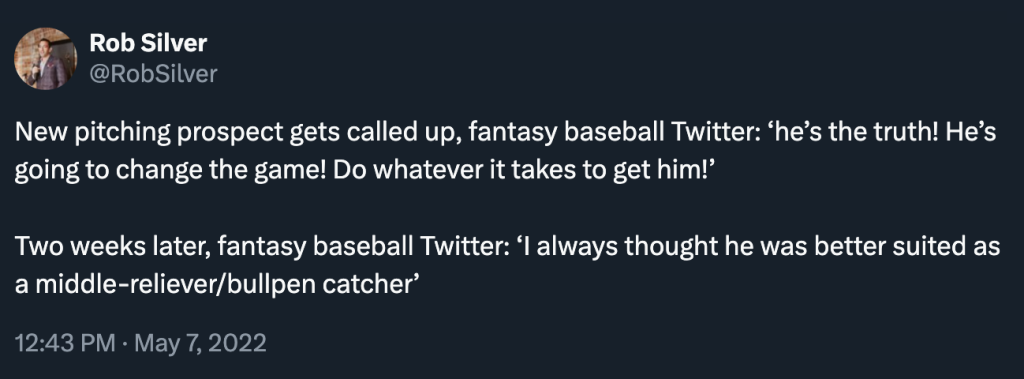
A 22 year old pitcher makes his debut, he faces (likely) a favorable matchup against a team like the Rockies or Angels at home. The pitcher strikes out seven in 6 innings while scattering six hits and only walking one. The FAAB bids are out of control. You manage to snag this pitcher in immediate add leagues and feel very good about yourself. The pitcher then faces the Braves on the road in his next turn and gives up 7 ER in 1.2 IP in an ugly start. You tell yourself, “Well, just a hiccup, but we saw how good this pitcher can be”. The pitcher proceeds to lay stinkers for two more starts than is optioned down to Triple-A. A tale a old as fantasy time. What can we do to avoid falling for these “debut mirages”?
There have been 88 starting pitcher debuts since the start of the 2024 season. Only 13 of the 88 threw a Quality Start, and among those, only three had more than 2 Quality Starts in their next 9 starts (and one was Shota Imanaga). So, a great start hardly means anything, but what actually means anything? I’m going to take a deep dive to figure out what’s going on.
First: The Good Start
We’re going to be judging a player’s start by the classic stat Game Score, developed by once beloved statistician and now professional online bad take giver Bill James. We’ll call a Game Score equal to or above 50 a “Good Start” and a Game Score below 50 a “Bad Start”. Looking at those 88 debuts, 44 of them were “Good Starts”, which is nice because it splits the debuts into two pools. Now, what I have below is examining the next 9 career games and averaging the Game Score across those 9 games (in totality, looking at the player’s first 10 games in the majors), and using that Good/Bad definition, here’s how they break down:
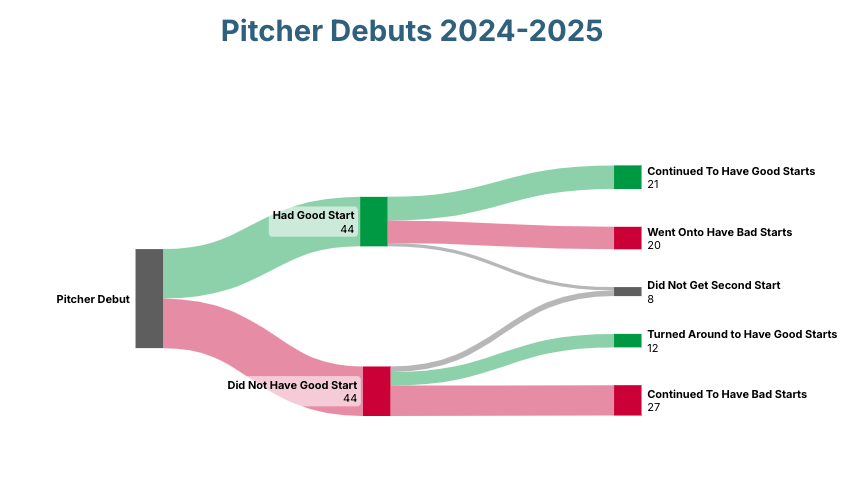
21 of the pitchers that had “Good” debuts continued to be good, while only 12 of the pitchers with “Bad” starts turned things around. Now I want to hyper focus on the 44 pitchers with the good debut because that’s who the Rob Silver tweet were talking about. Among those 44 pitchers is there anything we can say, “this is how you know that pitcher will continue to be good?” I’m going to break down the pool of pitchers based on certain “elements” they all have or didn’t have.
Element 1: The Strikeouts
Any savvy fantasy player knows if you see a quality start from a relative unknown pitcher, but that pitcher only had like 2 strikeouts than that would immediately raise a red flag. Perhaps that means if you only focused on the “Good” debuts that had a lot of strikeouts, then you should be golden! Let’s look at the Game Scores for the good debuts where the pitcher also had +7 strikeouts:
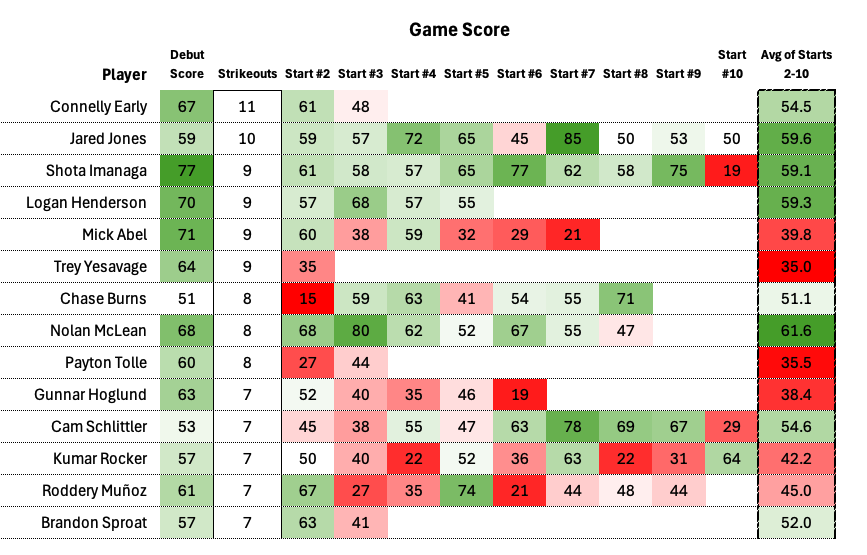
This seems pretty good. We’re seeing great pitchers like Imanaga and Jared Jones, but also, there is the cautious tale of Mick Abel right in the middle, and Trey Yesavage and Payton Tolle, who could’ve cost you greatly if you immediately picked them up for the H2H playoff run.
Element 2: The Prospect Pedigree
If a player has a good debut but has zero prospect pedigree, that seems like a red flag. If we can match up a good debut AND being listed as a future value 45+ or better prospect, that should give us a good list of “Stayed Good” pitchers! Well, here is the list of “Good” debuts among starting pitchers that had a 45+ FV grade or better:

There are definintely studs here (obviously with the prospect grade they received), but you can see even a future 50 FV pitcher like Gunnar Hoglund having a good debut didn’t guarantee future success.
Element 3: The Right Stuff+ (You Got It)
The strikeouts didn’t do the job, the prospect grade didn’t do the job, but what about (waves hand) the model number ?? A high Stuff+ number AND good start is a sure thing! The models don’t lie! Let’s go to the table of players with good debuts and their debut Stuff+ numbers (from @TJStats on twitter):
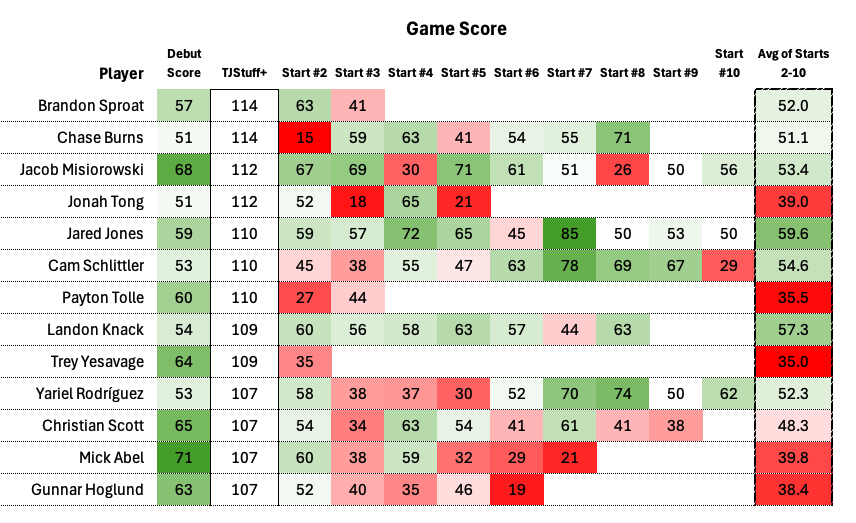
We’re seeing some promising results at the top, basically a super stuff pitcher with a good debut seems to be a good shot at seeing near-future success (except Jonah Tong).
Element 4: Let’s Put It All Together
The natural evolution from getting these elements is going to be putting them altogether, if someone had the strikeouts, the prospect pedigree, and the stuff+, this must be a can’t miss. Let’s see what happens:
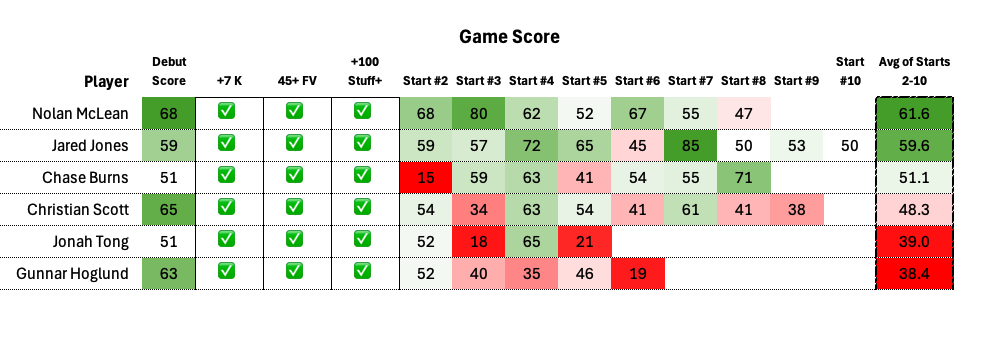
The resounding sentiment I got from this study is that Gunnar Hoglund needs to go away.
In Conclusion:
I don’t think we found a magic bullet to determine if a good start is a mirage or not, but one thing is for sure: these elements *do* matter. Just look at the average score based on how many of these elements a player had:
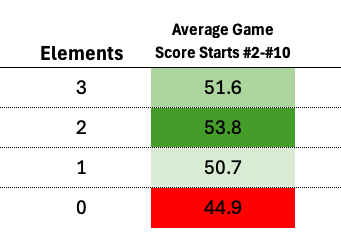
So the answer is when you see a good debut, assess those factors and act accordingly, and hopefully you will not be caught in the mirage.


